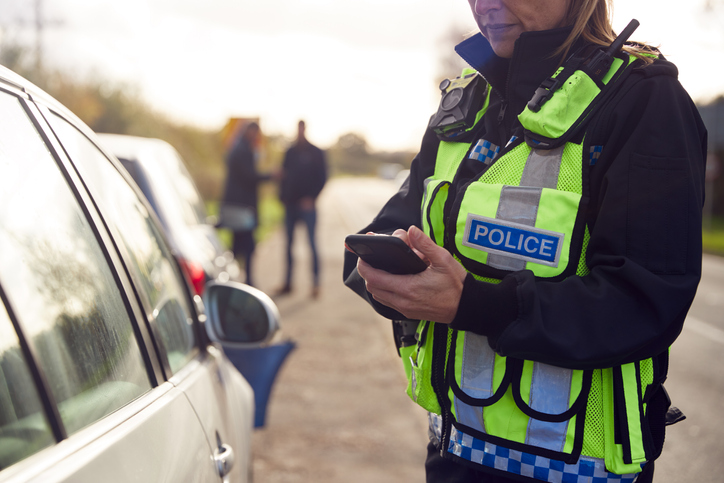Blog: The Power of Police Telematics and Fleet Tracking
28 September 2023
In a world where the preservation of public safety and the execution of effective law enforcement are critical, technology has risen as a formidable ally in the quest for secure communities. The combination of police telematics and fleet tracking systems is one such groundbreaking innovation that has dramatically transformed law enforcement operations. Throughout this blog post, we’ll dive deep into the world of police telematics and fleet tracking and unpack how these cutting-edge technologies are reshaping the public safety landscape in the UK.
The well-being and protection of its communities are the bedrock of any thriving society. Hence, it is crucial to equip our emergency services with tools that fortify their abilities to effectively address challenges, respond promptly, and preemptively deter crimes. This is where police telematics and fleet tracking enter the picture. These technologies enable law enforcement to harness real-time data, offering insights that amplify public safety endeavours.
Police telematics, a blend of telecommunications and informatics, is a comprehensive system that outfits law enforcement vehicles with sophisticated devices for the collection, analysis, and interpretation of real-time data. Leveraging the power of telematics allows law enforcement agencies to gain an advantage in their operations, facilitating informed decision-making grounded on precise information. From pinpointing the location of police vehicles to oversight of driver behaviour and optimising resource distribution, police telematics perform a pivotal role in bolstering public safety across the UK.
Fleet tracking, a critical aspect of law enforcement operations, pertains to the management of a vehicle fleet. Emergency service fleets grapple with unique challenges, spanning from swift response needs to effective resource allocation. Fleet tracking systems tackle these challenges by offering real-time tracking and monitoring capabilities, insights into vehicle location, status, and performance. By streamlining fleet operations, law enforcement agencies can guarantee faster response times, more efficient incident management, and ultimately, a more secure environment for their communities.
The integration of police telematics and fleet tracking technology yields a robust solution. This blend harnesses GPS tracking, vehicle diagnostics, and other telematics features to refine operations and maximise the effectiveness of law enforcement fleets. Real-time data collection, precise location tracking, and proactive vehicle management equip emergency fleets to promptly respond to incidents, prevent crimes, and optimise their resources to protect the public.
In this blog post, we’ll delve into the many applications of police telematics and fleet tracking. From crime deterrence and response to traffic management and resource optimisation, we’ll uncover the various ways these technologies augment public safety and empower emergency services to operate more efficiently.
Understanding Police Telematics
What is Police Telematics?
Police telematics is the integration of sophisticated telecommunications and informatics within the operations of emergency services. This involves the utilisation
of specific devices and systems fitted within police cars to gather, relay, and evaluate data in real time. These tools are engineered to record an extensive scope of information, encompassing parameters such as vehicle position, velocity,
acceleration, deceleration patterns, engine diagnostics, and more. By incorporating GPS, sensors, and data transmission modules, police telematics provides law enforcement with robust insights, enabling them to leverage data for
decision-making processes aimed at improving public safety.

Importance of Real-Time Data Collection and Analysis for Emergency Services
Having immediate access to data collection and interpretation is crucial for emergency service fleets. Being privy to live updates regarding the location of police cars, patrol routes, and various operations enables these agencies to react swiftly and competently to unfolding situations. This immediate data access facilitates dynamic decision-making, aiding in the efficient distribution of resources, coordinated action, and prompt recognition of developing patterns or potential threats. It furnishes a thorough understanding of the current situation, boosting the operation’s efficiency and the overall success of law enforcement activities.
Benefits of Police Telematics Systems in Enhancing Public Safety
Quicker Emergency Response: Leveraging real-time data collection and analysis, police forces can speedily pinpoint the closest units to incidents, thereby reducing response times. The result of this prompt action is the faster interception of wrongdoers, potential threat reduction, and an overall increase in public safety.
Boosted Situational Knowledge: Police telematics technology provides live location and activity updates for police vehicles, granting law enforcement officials a bird’s eye view of ground-level situations. This heightened situation comprehension enables effective resource distribution and coordination, leading to better crime response and prevention.
Active Efforts in Crime Deterrence: Utilising data gathered via telematics systems, police agencies can detect patterns, crime hotspots, and emerging trends in unlawful activities. This foresighted strategy of crime prevention can lead to resource deployment in high-risk areas, discouraging criminal activities and fostering safer communities.
Assisting in Evidence Gathering and Investigations: In-vehicle equipment like cameras and audio recorders in police telematics systems capture crucial evidence that can be pivotal in ongoing investigations.
Performance Oversight and Responsibility: Telematics data offers a deep dive into driver behaviour, protocol conformity, and regulation compliance by police personnel. This enables the police fleets to monitor and rectify any deviations, fostering a culture of accountability and professionalism within the force.
Police telematics systems offer immense advantages in terms of public safety. Real-time data collection, effective analysis, and informed decision-making based on the derived insights help law enforcement to act promptly, deter crimes, and build safer communities. By harnessing the capabilities of police telematics, law enforcement can enhance their operations, optimise resource allocation, and make a profound impact on public safety in the UK.
Police Fleet Tracking
What is Fleet Tracking and How is it Used by Police Forces?
In the realm of police operations, ‘fleet tracking’ is the term given to the continual supervision and control of a collection of vehicles used in diverse law enforcement tasks. This process employs cutting-edge tracking systems and software to gather live data on the whereabouts, condition, and functioning of vehicles. The assimilation of GPS trackers, sensors, and unified fleet management systems provides law enforcement bodies with a complete overview of their vehicle fleet’s actions, thereby enabling efficient supervision and control of their cars.

Importance of Efficient Fleet Management for Effective Emergency Service Operations
Effective fleet management forms the backbone of proficient operations within emergency service. Here are the reasons why it’s so crucial:
Optimum Utilisation of Resources: By enabling visibility into vehicle availability, usage patterns, and maintenance requirements, proficient fleet management ensures the best possible allocation of resources. It empowers law enforcement agencies to deploy the right vehicles at the appropriate time and place, thus boosting operational efficiency.
Prompt and Efficient Response: The use of fleet tracking systems allows for real-time location monitoring of each vehicle. This feature empowers dispatchers to identify and send the closest units to incidents promptly, leading to reduced response times and improved incident management.
Proactive Maintenance Approach: Insights from fleet tracking systems into vehicle diagnostics allow law enforcement bodies to keep tabs on vehicle health and maintenance needs. Proactively addressing these needs helps minimise unexpected breakdowns and downtime while enhancing vehicle reliability, ensuring the fleet is always ready for duty.
Driver Behaviour: Fleet management solutions also incorporate features to observe driver behaviour like speeding or harsh braking. Encouraging responsible driving and holding drivers accountable for their behaviour helps enhance overall driver safety, safeguards the public, and maintains the professionalism of the agency.
Efficient fleet tracking and management are vital to the triumph of law enforcement operations. By meeting the challenges faced by police fleets head-on and incorporating efficient tracking systems, agencies can maximise resource utilisation, boost response times, manage vehicle maintenance proactively, and ensure driver safety. With a well-managed fleet, law enforcement bodies can enhance their operational efficiency, improve public safety, and ultimately serve the public more effectively.
The Intersection of Police Telematics and Fleet Tracking
How Police Telematics Integrate with Fleet Tracking Systems
The fusion of police telematics and fleet tracking mechanisms forms a potent combination that boosts the efficacy of law enforcement actions. The technology
of police telematics, renowned for its ability to gather and examine data in real
time, melds effortlessly with fleet tracking systems to offer all-encompassing understanding of fleet functions and outputs. The unification of these two
technologies empowers law enforcement units to capitalise on their mutual advantages, paving the way for improved fleet administration and
amplified public safety.

The Role of GPS Tracking, Vehicle Diagnostics, and Other Telematics Features in Fleet Management
GPS Tracking: GPS tracking lies at the heart of fleet supervision, affording law enforcement bodies the ability to trace the exact real-time location of each vehicle. This critical information promotes efficient utilisation of resources, swift response to incidents, and well-coordinated operations. GPS tracking allows agencies to observe vehicle routes, spot any diversions from scheduled paths, and make decisions rooted in precise location data.
Vehicle Diagnostics: Telematics systems with vehicle diagnostics capabilities supply instant data related to vehicle performance, condition, and maintenance requirements. Emergency services can keep tabs on aspects like engine status, fuel usage, battery levels, and tire pressure. This data enables agencies to plan maintenance proactively, mitigating the likelihood of unforeseen breakdowns and ensuring vehicles are always operationally ready.
Driver Behaviour Monitoring: Telematics systems can also supervise driver behaviours such as speed, acceleration, and deceleration patterns. Emergency services can pinpoint hazardous driving actions and address them via tailored training modules, fostering safer driving habits and minimising accident risks.
Incident Documentation and Reporting: Telematics systems often incorporate in-vehicle cameras or audio recording tools. These elements yield valuable evidence during incidents or public encounters. The recorded data acts as an impartial reference point for incident investigations, ensuring accurate documentation, and aiding justice.
Benefits of Combining Police Telematics and Fleet Tracking for Public Safety
Merging police telematics with fleet tracking systems provides several advantages that boost public safety.
Improved Situational Awareness: The fusion of telematics and fleet tracking supplies emergency services with live data on vehicle whereabouts, efficiency, and driver conduct. This all-around situational insight allows agencies to react quickly to situations, distribute resources wisely, and make thought-out decisions based on solid data, leading to improved public safety.
Proactive Incident Management: Using live telematics data, authorities can pinpoint the closest available units to deal with issues, enhance the efficiency of response routes, and effectively manage resources. This forward-thinking approach to managing incidents lessens response delays and paves the way for quick and efficient intervention, preventing potential risks from intensifying and protecting the community.
Data-Driven Decision Making: The integration of telematics and fleet tracking equips law enforcement agencies with a treasure trove of data that can be analysed and used to make educated decisions. Insights on vehicle performance, driver conduct, and incident patterns empower agencies to enact data-driven strategies, distribute resources effectively, and streamline operational procedures, leading to more successful law enforcement and enhanced public safety outcomes.
By effectively utilising police telematics and fleet tracking, fleets can utilise cutting-edge technologies to improve their fleet management practices, optimise resource distribution, and base their decisions on solid data. The smooth integration of these technologies enables efficient police fleet management.
Key Applications of Police Telematics and Fleet Tracking in the UK
Crime Prevention and Response
Advanced telematics and fleet monitoring technology play a key role in police work and crime prevention, offering substantial benefits for emergency responsiveness. By harnessing real-time data and geographical tracking, law enforcement authorities can improve their effectiveness in managing and countering crime. This technology finds its utility in several main areas.
Proactive Policing: Telematics technology allows police departments to pinpoint
high-risk crime regions and adeptly allocate patrols. The immediate access to vehicle location data enables police to focus their resources strategically, helping to deter potential criminal activities and bolster overall community security.
Crime Pattern Analysis: Gathering and scrutinising data drawn from fleet tracking systems allows the creation of crime maps. These reveal crime tendencies, focal points, and movements, enabling law enforcement to distribute resources prudently, identify emerging trends, and create specialised strategies for effective crime control.

Swift Emergency Response: Through the combination of telematics and fleet monitoring, police can quickly identify the closest available units to respond to incidents, subsequently reducing response times. Real-time positioning data empowers dispatchers to make prompt, informed decisions, ensuring resources are mobilised expeditiously to counter threats, arrest suspects, and provide necessary support to those in distress.
Traffic Management and Accident Analysis
Telematics and fleet tracking technologies are essential tools for law enforcement, proving invaluable in traffic management and accident analysis. These systems, harnessing real-time data, enable police departments to bolster road safety measures, manage traffic more efficiently, and conduct thorough accident investigations.
Traffic Supervision and Management: Telematics provides precise, current information regarding traffic status, which empowers law enforcement agencies to keep a close watch on congestion, pinpoint traffic hotspots, and introduce necessary traffic management solutions. This capability facilitates improved traffic circulation, minimises hold-ups, and promotes safer roads.
Accident Evaluation: Crucial accident-related data, such as the vehicle’s speed, collision intensity, and exact location, are recorded by fleet tracking systems. This data aids law enforcement in accident inquiries, recreating the incident scene, and accurately determining responsibility. Utilising this information allows for the identification of high-risk locations, the creation of targeted strategies to decrease accidents, and the enhancement of overall road safety.
Resource Allocation and Dispatch Optimisation
For emergency service fleets, effective deployment of resources and well-planned dispatching are of paramount importance. Insights drawn from police telematics and fleet tracking systems are instrumental in fostering an environment of efficiency and effectiveness:
Optimal Resource Allocation: By analysing telematics data, these entities can keep track of vehicle usage, fuel consumption, and maintenance requirements. This data aids in the strategic allocation of vehicles, optimisation of the fleet size, and overall operational efficiency boost. By tailoring the fleet to match the operational needs, costs can be minimised while ensuring sufficient vehicles are always in service.
Streamlining Dispatch Processes: The real-time location information provided by fleet tracking systems allows for improved dispatching. It becomes possible to pinpoint the closest available units to the incident location, choose suitable resources based on the specific situation, and deploy them without delay. As a result, the response to incidents becomes faster and management more efficient, significantly improving public safety.
Vehicle Maintenance and Optimisation
Telematics and fleet tracking technologies play an essential role in managing and optimising law enforcement vehicles, enhancing their dependability and lifespan.
Proactive Maintenance: By delivering real-time data on vehicle conditions, telematics systems can promptly spot potential issues, allowing for timely maintenance. This early detection of problems, facilitated by careful monitoring of the vehicle’s diagnostics and performance metrics, enables law enforcement agencies to adopt a proactive stance towards maintenance, curtail vehicle downtime, and increase the fleet’s readiness for operations, thereby reducing the potential for breakdowns during crucial tasks.
Fuel Efficiency and Expense Reduction: Telematics systems record data pertaining to fuel usage and driving patterns. This information can be scrutinised by law enforcement agencies to glean valuable insights for enhancing fuel efficiency, reducing unnecessary vehicle idling, and devising driver training modules. This optimisation of fuel consumption contributes to significant cost reductions.
Recapping the Importance of Police Telematics and Fleet Tracking in Enhancing Public Safety
This comprehensive post delves into the significance of police telematics and fleet tracking technologies, shedding light on their critical role in bolstering public safety within the United Kingdom. These highly sophisticated systems offer fleets a range of tools and functionalities, crucially enhancing community safety and operational efficiency.
Police telematics and fleet tracking stand as indispensable assets, supplying law enforcement with immediate access to data, location tracking, and vehicle diagnostics – all vital for effective resource distribution, swift incident response, proactive crime deterrence, and overall public safety improvement.
By integrating telematics and fleet tracking seamlessly, law enforcement agencies obtain unmatched situational knowledge, equipping them to make well-informed decisions, allocate resources optimally, and respond promptly to emergencies. The net result is safer neighbourhoods, lower crime rates, and an elevated living standard for residents and communities throughout the UK.
Ongoing Advancements and the Potential for Further Improvements in the Future
Wrapping up our discussion about police telematics and fleet management, it’s essential to understand that technological progression in this sector is relentless. Developments in areas such as data interpretation, artificial intelligence, and network connectivity are set to bring about substantial benefits to police forces going forward. Trends like predictive analytics, machine learning, and the Internet of Things (IoT) have the potential to advance police telematics and fleet monitoring systems even further. They are poised to allow police forces to anticipate and thwart crime more effectively, fine-tune the allocation of resources, and respond more swiftly and accurately to emergencies. Additionally, by adopting environmentally friendly choices like electric and hybrid vehicles, the carbon footprint of police fleets can be lessened, leading to significant cost savings that can be channelled towards enhancing public safety initiatives.
To conclude, police telematics and fleet tracking technologies have already demonstrated their effectiveness in improving public safety in the UK by providing real-time data, simplifying operations, and facilitating data-driven decision-making. As we look ahead, we can expect further advancements in police telematics that will reshape the public safety and law enforcement landscape, ensuring an even safer and more secure future for all.
Want more information?
Get in touch today to find out how you can make your officers more productive.
Contact Us